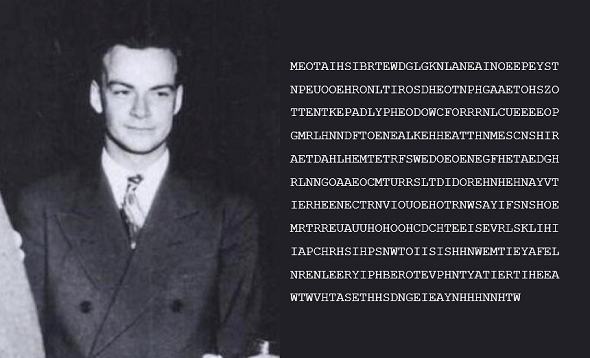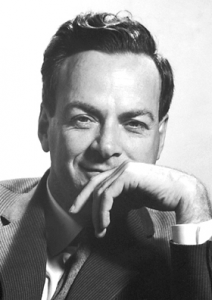Three encrypted texts left behind by Nobel Prize winner Richard Feynman are probably the most famous crypto mystery I have never blogged about before. Today, this is going to change.
In 1987 a certain Chris Cole posted the following note in the usenet group sci.crypt:
When I was a graduate student at Caltech, Professor Feynman showed me three
samples of code that he had been challenged with by a fellow scientist at
Los Alamos and which he had not been able to crack. I also was unable to
crack them. I now post them for the net to give it a try.
The professor Feynman mentioned in this post was none other than American theoretical physicist Richard Feynman (1918-1988), who received the Nobel Prize in Physics in 1965.
Feynman was a member of the team that built the first atomic bomb in Los Alamos (Manhattan Project) during the second World War. He had no special interest in cryptology, but apparently the time in Los Alamos, in the middle of the desert of New Mexico, was quite boring, so he occupied himself with the crypto puzzles his fellow scientist gave him. He couldn’t solve them.
The Feynman cryptograms are mentioned in my book Codeknacker gegen Codemacher. However, I have never blogged about them before. I suspect that the Feynman cryptograms are the most famous crypto mystery I have never introduced on this blog so far.
The first Feynman cryptogram
The solution of the first Feynman cryptogram was found soon after it had been posted in the sci.crypt newsgroup. Here’s the ciphertext:
MEOTAIHSIBRTEWDGLGKNLANEAINOEEPEYST NPEUOOEHRONLTIROSDHEOTNPHGAAETOHSZO TTENTKEPADLYPHEODOWCFORRRNLCUEEEEOP GMRLHNNDFTOENEALKEHHEATTHNMESCNSHIR AETDAHLHEMTETRFSWEDOEOENEGFHETAEDGH RLNNGOAAEOCMTURRSLTDIDOREHNHEHNAYVT IERHEENECTRNVIOUOEHOTRNWSAYIFSNSHOE MRTRREUAUUHOHOOHCDCHTEEISEVRLSKLIHI IAPCHRHSIHPSNWTOIISISHHNWEMTIEYAFEL NRENLEERYIPHBEROTEVPHNTYATIERTIHEEA WTWVHTASETHHSDNGEIEAYNHHHNNHTW
The letter frequencies of this message are pretty similar to the ones of a plain English text. This means that most likely a transposition cipher has been used to encrypt it. As it turns out, it was even a pretty simple transposition cipher that created this message. It can be broken with a simple trick I have mentioned a few times before on this blog.
All we need to do is write the ciphertext in different line lengths and check whether something can be read (line-wise or column-wise, forward or backward). As we deal with 380 letters, line lengths 4, 5, 10 and 19 are good candidates (these are the divisors of 380). We’ll skip the four-letter attempt (it doesn’t lead to the solution) and start with five-letter blocks:
MEOTA IHSIB RTEWD GLGKN LANEA INOEE PEYST NPEUO OEHRO NLTIR OSDHE OTNPH GAAET OHSZO TTENT KEPAD LYPHE ODOWC FORRR NLCUE EEEOP GMRLH NNDFT OENEA LKEHH EATTH NMESC NSHIR AETDA HLHEM TETRF SWEDO EOENE GFHET AEDGH RLNNG OAAEO CMTUR RSLTD IDORE HNHEH NAYVT IERHE ENECT RNVIO UOEHO TRNWS AYIFS NSHOE MRTRR EUAUU HOHOO HCDCH TEEIS EVRLS KLIHI IAPCH RHSIH PSNWT OIISI SHHNW EMTIE YAFEL NRENL EERYI PHBER OTEVP HNTYA TIERT IHEEA WTWVH TASET HHSDN GEIEA YNHHH NNHTW
If we read the first column bottom-up we get: NYGHTWITHOPENYES… This looks like English plaintext with misspelled words (“Nyght with open [e]yes …”). The other four columns make sense, too, when read backwards. Read the whole message from lower right upward we get:
WHANT HAT APRILLE WITH HIS SHOURES SOOTE THE DROGHTE OF MARCH HATH PERCED TO THE ROOT …
This is an excerpt from Geoffrey Chaucer’s Canterbury Tales, a famous story collection written in the 14th century.
Feynman cryptograms #2 and #3
The second and the third Feynman cryptogram have never been solved. Here’s cryptogram #2:
XUKEXWSLZJUAXUNKIGWFSOZRAWURORKXAOS LHROBXBTKCMUWDVPTFBLMKEFVWMUXTVTWUI DDJVZKBRMCWOIWYDXMLUFPVSHAGSVWUFWOR CWUIDUJCNVTTBERTUNOJUZHVTWKORSVRZSV VFSQXOCMUWPYTRLGBMCYPOJCLRIYTVFCCMU WUFPOXCNMCIWMSKPXEDLYIQKDJWIWCJUMVR CJUMVRKXWURKPSEEIWZVXULEIOETOOFWKBI UXPXUGOWLFPWUSCH
And here’s the third cryptogram:
WURVFXGJYTHEIZXSQXOBGSVRUDOOJXATBKT ARVIXPYTMYABMVUFXPXKUJVPLSDVTGNGOSI GLWURPKFCVGELLRNNGLPYTFVTPXAJOSCWRO DORWNWSICLFKEMOTGJYCRRAOJVNTODVMNSQ IVICRBICRUDCSKXYPDMDROJUZICRVFWXIFP XIVVIEPYTDOIAVRBOOXWRAKPSZXTZKVROSW CRCFVEESOLWKTOBXAUXVB
As far as I know, there are not very many analyses of the two unsolved Feynman ciphers. Nick Pelling has posted a few articles about them.
If you are aware of other sources about this crypto mystery or if you know how these cryptograms might be solved please let me know.
Follow @KlausSchmeh
Further reading: The Top 50 unsolved encrypted messages: 44. A WW2 encryption hidden in a bullet
Linkedin: https://www.linkedin.com/groups/13501820
Facebook: https://www.facebook.com/groups/763282653806483/




Kommentare (3)